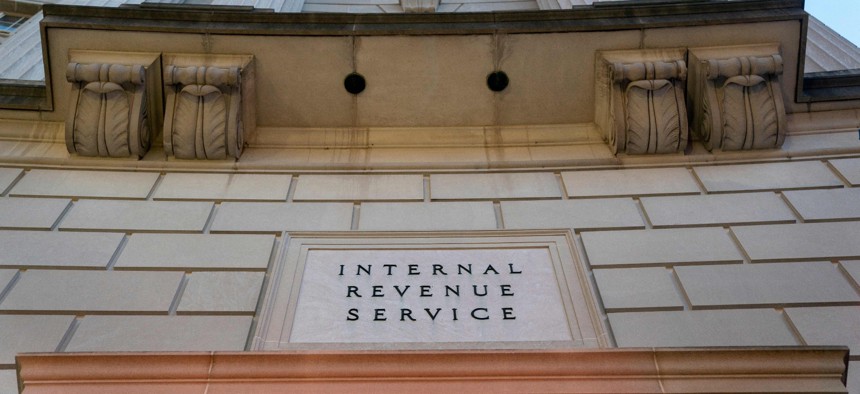
The IRS plans to raise its workforce to 105,000 by fiscal 2025 in an effort to close the tax gap. STEFANI REYNOLDS / Getty Images
IRS says 33% staff increase over two years will help address growing unpaid tax total
The tax agency will need to hire as many as 52,000 employees by 2025 to reach its staffing goals.
American households and businesses underpaid their taxes by $688 billion in 2021, according to new data the Internal Revenue Service released on Thursday, a figure it hopes to drive down significantly in the coming years after a forthcoming surge in staffing levels.
The unpaid tax total, known as the “tax gap,” climbed by 25% compared to the 2017-2019 period, the most recent data IRS had previously made available. The true figure is likely significantly higher, IRS officials said, as the amount does not reflect a full accounting of all assets on which Americans did not pay taxes.
IRS has for years bemoaned the growing tax gap, saying it can't compete with the resources that high-income and corporate taxpayers deploy to avert paying what they owe. Thursday’s release marks the first time IRS released a single-year tax gap and, officials said, underscored the importance of the efforts the agency is taking to beef up its enforcement capacity. Agency leadership has previously estimated the gap could be over $1 trillion annually and officials said Thursday they are actively working on updating their methods for making that calculation.
The vast majority of the tax gap is made up of individuals or businesses underreporting what they owe, though some entities also do not file at all or underpay their debts. The agency still expects to recover $63 billion through ongoing enforcement, though it hopes to grow that clawback rate in future years. That optimism is in large part due to the Inflation Reduction Act, which sought to provide the agency with $80 billion over 10 years to improve enforcement and customer service.
IRS has so far spent just $2 billion of that total, according to an early review by the Treasury Inspector General for Tax Administration, though it anticipates ramping that up quickly in the coming months. The agency has spent $721 million on pay and benefits and $720 million on contractor personnel. Most of the hiring so far has gone toward improving customer service and boosting call center staffing. That has led to some successes, as the agency increased its phone answering rate from 10% in 2022 to nearly 90% this year and has newly opened or reopened 42 Taxpayer Assistance Centers.
The agency has grown its workforce to more than 90,000 employees—up front 79,000 at the end of fiscal 2022—though that represents less than half of the hiring it plans to make by fiscal 2025. IRS expects to grow its workforce to 105,000 employees by that year, which would mark a 33% increase from fiscal 2022. Much of that growth will be driven by surging staffing in enforcement, where TIGTA said IRS will attempt to implement a 35% employee boost. It has so far spent just 0.2% of the $44.2 billion the Inflation Reduction Act allocated for tax collection.
The auditors said IRS will face “considerable challenges” toward meeting its goals, noting the agency expects to lose one-third of its employees to attrition by fiscal 2025. That would require a total onboarding of 52,000 new employees. The growth it has already seen, however, puts its lofty projections within reach.
The next batch of hiring could prove more difficult, however, as Melanie Krause, IRS’ chief data and analytics officer, noted it will target tax professionals with experience in sophisticated subject matters. She added that once those employees are onboarded, it will drive better outcomes in tax collection.
“The additional staff and hiring at more senior levels is really a critical aspect of being able to expand our coverage in some of these areas, particularly the large corporate space and complex passive entities,” Krause said.
She added shrinking the tax gap will require a combination of more employees and improved use of technology so the examinations IRS personnel conduct are “as efficient as possible and as productive as possible.” Krause said IRS is also looking to “rebalance the portfolio” by redeploying existing staff for “areas of strategic importance.”
IRS Commissioner Danny Werfel previously announced the agency is using IRA funds to target 1,600 millionaires it has identified as owing at least $250,000 in taxes each. It also launched an initiative focusing on taxes owed by “large partnerships,” which will include hedge funds, real estate investment partnerships, publicly traded partnerships, large law firms and other entities.
“The tax gap increase underscores the importance of increased IRS compliance efforts on key areas,” Werfel said. “With the help of Inflation Reduction Act funding, we are adding focus and resources to areas of compliance concern, including high-income and high-wealth individuals, partnerships and corporations.”
IRS officials stressed to the IG the agency needs annual appropriations increases to keep pace with its steady state. If funding is flat in fiscal 2024, as appears likely due to the spending caps in place, it will have to tap IRA funds just to avoid cuts. Congress already zeroed out funding for modernization in fiscal 2023, requiring the agency to use IRA money for those efforts as well. As part of the Fiscal Responsibility Act President Biden struck with House Republicans to increase the debt ceiling as set funding levels, the two sides agreed to reduce the IRA funds for IRS by $20 billion and redirect that spending elsewhere.







